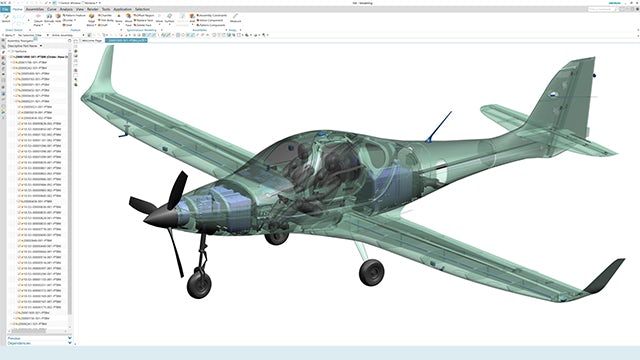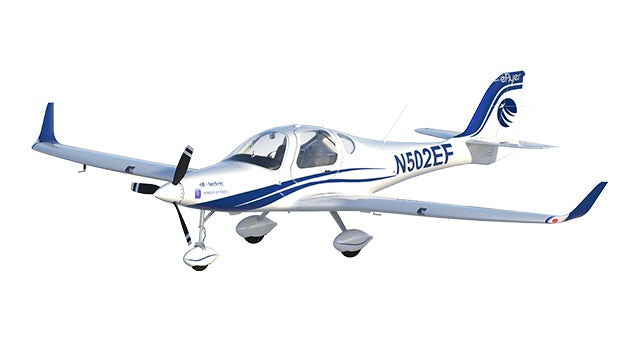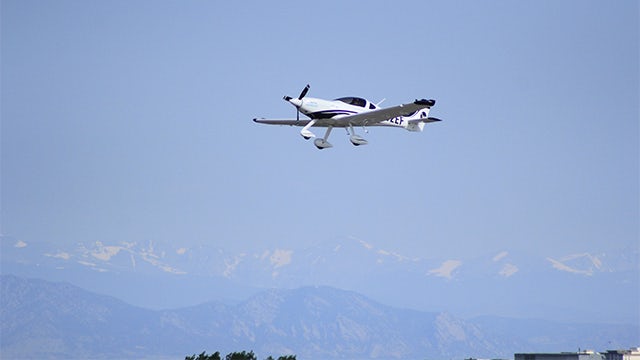Airplane manufacturer uses Siemens solutions to reduce product development time for all-electric composite aircraft
NX, Fibersim and Simcenter enhance Bye Aerospace productivity with 66 percent fewer engineering staff
Bye Aerospace
Bye Aerospace specializes in the design and manufacture of electric aircraft, including light aircraft for flight training. The firm also develops and integrates structural and mechanical systems along with aerodynamic advances in design, building products that offer significant cost benefits and improved performance
http://www.byeaerospace.com/- Headquarters:
- Englewood, Colorado, United States
- Products:
- Capital, NX, Fibersim, Simcenter 3D Software, Simcenter Products, Simcenter STAR-CCM+, Teamcenter
- Industry Sector:
- Aerospace & defense
The NX CAD software in particular that we’re using right now is a technology enabler. It keeps Bye Aerospace in front.
Bye Aerospace, Inc.
A disruptive change
When George Bye was eight years old his mother took him on his first flight in a Piper Cub. He has been hooked on aviation ever since. First as a U.S. Air Force pilot and trainer, then as an aerospace engineer and teacher and now as the chief executive officer (CEO) and founder of Bye Aerospace (Bye), he is driven by the idea of bridging the past with the future of aviation.
“What’s disruptive and changes the opportunity with electric aircraft is the propulsion system,” says Bye. “The trajectory for electric motors and batteries and their evolution from 10 and 20 years ago to the present day makes it possible for the first time to develop an aircraft that is very disruptive, has lower operating costs, no CO2 and very low noise. That’s the piece that changes everything.”
Seeking FAA certification
Bye Aerospace has two electric aircraft projects well underway in the Federal Aviation Administration (FAA) 14 Code of Federal Regulations (CFR) 23 aircraft certification process with the first and most important the two-seat eFlyer 2 training aircraft. These two projects range from the ready-to-purchase to research and development (R&D) stage.
“FAA certification is the gateway to quality and the gateway to safety,” says Bye. “For the first time ever, we now have a process with them for electric propulsion of airplanes.”
“We are groundbreaking, if you will, out on the leading edge of certification,” says Tom Bowen, chief engineer. “We have a very cooperative relationship with the FAA because we are the first. We are the first aircraft to certify with electric propulsion to the FAR 23 standards. So, they depend a lot on us to not only interpret the technology, but to tell them how it relates to the rules and how they should apply the methods of compliance so we can show that we meet their standards.”

Seamlessly transitioning from design to analysis
The eFlyer 2 is an all-composites airplane with advanced aerodynamics, high technology and the latest in avionics. It has a low part count yet it’s a robust system, which makes it a durable aircraft.
One of the aircraft’s compelling points is the flying range, which the weight directly affects so using composites is a critical part of their strategy. The Bye Structures Department has used several solutions from Siemens Digital Industries Software to help them get off the ground, most notably the Fibersim™ portfolio and NX™ software. They are using Fibersim to optimize the structural integrity of the composite air frame and NX to develop the outer shape of the plane. Fibersim is used to build up the layers of composites from the outside in.
The firm also uses Teamcenter® software for product data and end-to-end management, Simcenter™ STAR-CCM+™ software for computational fluid dynamics (CFD), Simcenter 3D software for analysis, testing and certification and Capital™ software for wire harness and layout. Using these five products, which are part of Siemens Xcelerator business platform of software, hardware and services, has enabled Bye to create a seamless endto-end process.
“The reason we use NX instead of another CAD system is because it has a more seamless transition from design to analysis, which gives us more time to do more iterations on our design,” says Parijaat Malik, senior mechanical systems engineer. “We’re able to easily make a few changes and analyze that design and just make the changes that we need to make that particular design work. Also, one of the biggest things NX provides is wave linking, which makes parametrizing assembly so much more robust than any other CAD software that’s available.”

A foundation for future products
“The eFlyer family of airplanes begins with the eFlyer 2,” says Bowen. ”The effort that we’re putting into defining the eFlyer 2 in Siemens software is the foundation for all the future products. The typical program sequence when changing models is what we call a tear-up phase, where we take what doesn’t fit our future model and we tear it up and then we start over on our design.
“Siemens software allows us to more or less morph, or what we call rubber band, this design into the next design and into the design beyond that. The advantage is, of course, it’s not only a physical change or a modeling change, but it also has the analysis resources linked to that one source of truth, which is the model. So, when we modify the model, all the other related activities also morph with the aircraft.”
“So, what helps Bye Aerospace be agile in our design process is the wave linking; the ability to create a top-down structure where you can take something as simple as a shape and break it down into pieces and pass it down to the people that are responsible for designing those pieces and add detail into it,” says Malik. “And because of wave linking, you are able to easily pass your design changes to other designers without having to have big meetings to communicate your design changes, to make sure that you have to change a bunch of things just to accommodate someone else’s changes. You can just open an assembly and see whatever’s linked to it and see the changes that were made on the other person’s side and how that affects your design. Then you can make the required changes to accommodate the design as a whole.”

Every plane starts from the conceptual design. It is based on the company’s idea of what the plane should look like and what its performance characteristics need to be. Based on that, Bye starts designing the systems inside the aircraft.
“Siemens software plays into that because you start your conceptual design with what we call a simple optimal line, which is the shape of the aircraft in NX,” says Malik. “You start detailing those and based on composites that you need to use and the stresses that act on the structure of the aircraft, you can go into Fibersim and have a layout that details what plies and what the sequence of those plies needs to be in the structure.
“And you can put the data from Fibersim into NX, which gives you the right amount of thickness in your structure and the right surfaces that you need to mount your systems on.”

Designing with change in mind
“We design the eFlyer 2 with change in mind,” says Jim Forrester, director of design and engineering. “We’re using a top down design process enabled by wave, which is a capability in NX. It enables Bye to simply update the models to reflect all changes. “We can take that eFlyer 2 and in the end we’ll change that aerodynamic shape to what it needs to be for an eFlyer 4 and then we’ll morph the eFlyer 2 into an eFlyer 4. I anticipate that will take about a week to do. It’s an order of magnitude savings.
“We can either do the same number of iterations in less time, or we can do more iterations in the same amount of time. At Bye Aerospace, we’re doing both. We’re shrinking our product development time and doing more iterations at the same time. In the end what that allows us to do is to get to market fast with the right plane.”

A “technology enabler”
“With a typical program, you get two iterations,” says Bowen. “If you’re doing a very good job, you get three. With the Siemens solutions, you can actually iterate on a weekly basis, so being able to dial in and iterate to a 99 or 100 percent solution to your requirements is the biggest advantage I see of having all Siemens software integrated.
“We have 20 people on the engineering team. A typical company would have 50 to 60. The reason we can do that is because Siemens software is so integrated that you don’t need the traditional specialists.”
“As a systems engineer, I feel the biggest advantage of the Siemens software is how it makes design more collaborative,” says Parijaat Malik.
“The NX CAD software in particular that we’re using right now is a technology enabler. It keeps Bye Aerospace in front,” says Bye. “The ability to capture all of the aspects of an airplane design is greatly enabled. In capturing the eFlyer 2, Siemens software is particularly capable of helping us to transition to what comes next.”

As a systems engineer, I feel the biggest advantage of the Siemens software is how it makes design more collaborative.
Bye Aerospace, Inc.